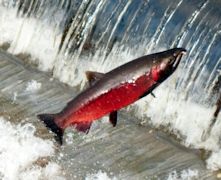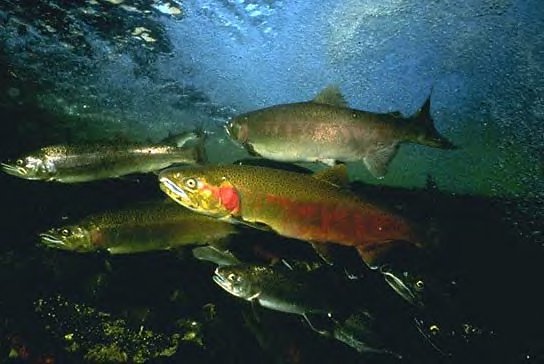Trouts and salmons
Description
To 3'3" (99 cm). Elongate, fusiform, moderately compressed; blue-green above, silvery-white below; irregular dark spots on back and sometimes on upper lobe of caudal fin. Gums at base of teeth white or gray. Adipose fin present; striations on caudal fin rays rough.
Endangered Status
The Coho Salmon is on the U.S. Endangered Species List. Certain naturally spawned populations in California and Oregon are classified as threatened. This salmon's numbers in Oregon dropped from 1.4 million in 1900 to 20,000 less than 100 years later. In Washington the Coho is virtually extinct, and in California the population has dropped from half a million in the 1940s to a few thousand today. Many factors have exterminated the Coho Salmon from its historic range, including alterations to its habitat caused by livestock grazing, mining, pollution, water-diversion, and urban development. The biggest impact has been dealt by the logging industry. Cutting of trees exposes the salmon's spawning streams to sunlight, which heats the water to temperatures that are lethal to these fish. Additionally, erosion from logging activies causes the steams to silt up and become too muddy for the fish and their eggs to survive in. The logging industry opposes measures that would help conserve salmon habitats and restore populations.
Habitat
Inshore waters at mid-depths or near surface; spawns in coastal streams, sometimes far inland.
Range
From Bering Straight to Baja California; coastal streams south to Monterey, California. Introduced elsewhere, especially in Great Lakes.
Discussion
Like all Pacific salmons, the Coho Salmon is anadromous. The adult spawns in small streams, where the female deposits 2,500 to 5,000 eggs in the gravel during the autumn. Both the male and the female die after spawning. The young stay in the streams for about a year before migrating to the ocean, where they remain for 2 or 3 years. The Coho Salmon is a game fish prized both as a fighter and for eating. It also supports a large commercial fishery off Oregon and Washington.




